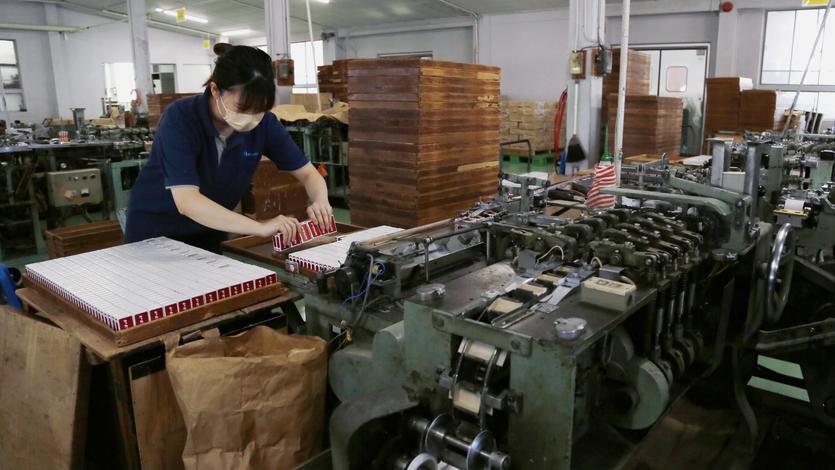 Workers of the Aluminium Sabart foundry work on the manufacture of an aluminium "billet" at the Tarascon-sur-Ariege plant, southern France, on Sept 9, 2022. (PHOTO / AFP)
Workers of the Aluminium Sabart foundry work on the manufacture of an aluminium "billet" at the Tarascon-sur-Ariege plant, southern France, on Sept 9, 2022. (PHOTO / AFP)
TOKYO - Global factory activity weakened in March as consumers feeling the pinch from rising living costs cut back, surveys showed on Monday, suggesting a deteriorating outlook will remain a drag on economic recoveries and keep policymakers on their toes.
Although factories across the euro zone saw a further decline last month, the cost of manufacturing fell for the first time since mid-2020.
S&P Global's final euro zone manufacturing Purchasing Managers' Index (PMI) fell to 47.3 in March from February's 48.5, just ahead of a preliminary reading of 47.1 but below the 50 mark separating growth from contraction for a ninth month.
An index measuring output, which feeds into a composite PMI due on Wednesday that is seen as a good guide to economic health, did however rise to a 10-month high of 50.4 from 50.1.
"Today's PMI results highlight that challenges remain for manufacturing companies. Although consumer demand has largely held across sectors, this could lessen gradually," said Thomas Rinn, global industrial lead at Accenture.
ALSO READ: De-risking global economy high on G20 meeting agenda
 A worker handles boxes of matches as they are produced on an assembly line at a Nittosha factory in Himeji, Japan, June 29, 2022. (YURI KAGEYAMA / AP)
A worker handles boxes of matches as they are produced on an assembly line at a Nittosha factory in Himeji, Japan, June 29, 2022. (YURI KAGEYAMA / AP)
German manufacturing activity shrank in March at the fastest pace in almost three years, while weak demand continued to drag down France's factory sector as purchasing managers turned pessimistic about the 12-month outlook for their businesses.
S&P Global's final euro zone manufacturing Purchasing Managers' Index (PMI) fell to 47.3 in March from February's 48.5, just ahead of a preliminary reading of 47.1 but below the 50 mark separating growth from contraction for a ninth month
In Britain, outside the European Union, manufacturers also slipped, but did turn more optimistic about the future as cost pressures and supply chain problems eased.
The improving supply chains and lower energy costs meant input prices fell in the euro zone for the first time since July 2020 - just when the COVID-19 pandemic was cementing its grip.
But oil prices surged on Monday, posting the biggest daily rise in nearly a year, after a surprise announcement by OPEC+ on Sunday to cut more production, likely adding to inflationary pressures.
Asian strain
Export-reliant Japan and South Korea both saw manufacturing activity contract in March, highlighting the challenge facing Asia as authorities try to keep inflation in check and fend off headwinds from slackening global economic momentum.
"With global growth set to remain weak in the coming quarters, we expect manufacturing output in Asia to remain under pressure," said Shivaan Tandon, emerging Asia economist at Capital Economics.
 Tugboats assist a container ship docked at the Manila North Harbour Port, Inc (MNHPI) in Manila, Philippines, on Oct 19, 2021. (PHOTO / AP)
Tugboats assist a container ship docked at the Manila North Harbour Port, Inc (MNHPI) in Manila, Philippines, on Oct 19, 2021. (PHOTO / AP)
South Korea's PMI fell to 47.6 in March from 48.5 in February, its weakest in six months as export orders took a hit.
Japan's final au Jibun Bank PMI stood at 49.2 in March, up from February's 47.7 but remaining below the 50-threshold, as new orders contracted for a ninth-consecutive month.
A separate central bank survey released on Monday showed Japanese big manufacturers' sentiment soured in January-March to its worst in more than two years, as weak external demand added to the struggle for firms already grappling with rising raw material costs.
ALSO READ: Survey: Japan's factory activity down fastest in 2.5 years
A separate central bank survey released on Monday showed Japanese big manufacturers' sentiment soured in January-March to its worst in more than two years, as weak external demand added to the struggle for firms already grappling with rising raw material costs
India was a rare bright spot in the region, with its manufacturing sector expanding at its quickest pace in three months in March on improved output and new orders, suggesting its economy is better placed than most of its peers to weather a global slowdown.
Vietnam and Malaysia saw factory activity shrink in March, while that of the Philippines expanded at a slower pace than in February, surveys showed.
While supply disruptions caused by the pandemic have mostly run their course, weak chip demand and fresh signs of slowdown in global growth have emerged as risks to many Asian economies.
The collapse last month of two US banks and the take-over of Credit Suisse have added to uncertainty over the global outlook by causing market turbulence and shedding light on potential vulnerabilities in the world financial system.
READ MORE: Report: Regional economic integration advancing in Asia
While indications are that the US Federal Reserve will pause its tightening cycle soon, the outlook remains clouded by the banking-sector troubles, still-high inflation and slowing global growth.


